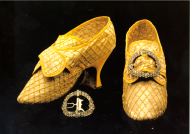Dress Rehearsal
Before the French Revolution, courtly culture and the fashions that went
along with it were intricately tied up with the ballet. Performed
by aristocrats
and nobles, ballet was an important aspect of courtly entertainment and
contemporary dress and footwear carried over into these performances.
Fashionable shoe, both male and female, sported a heel, which bespoke the
wearer’s noble standing. Originally contrived to keep feet firmly
fixed in stirrups, heels became extremely vogue, adding height and grandness
to upper-class men and women (Lee
1999). To lend
support to the foot and to keep the instep of the shoe from breaking under
the
weight of the wearer,
the leather soles of these shoes were relatively think and rigid, spanning
the entire base of the foot (Personal
Observations).
These shoes tended to be elaborately decorated and, in any case, would
have been in
the performance
of courtly
ballets,
which were danced before and by the aristocracy (and occasionally the king,
himself).
aristocrats
and nobles, ballet was an important aspect of courtly entertainment and
contemporary dress and footwear carried over into these performances.
Fashionable shoe, both male and female, sported a heel, which bespoke the
wearer’s noble standing. Originally contrived to keep feet firmly
fixed in stirrups, heels became extremely vogue, adding height and grandness
to upper-class men and women (Lee
1999). To lend
support to the foot and to keep the instep of the shoe from breaking under
the
weight of the wearer,
the leather soles of these shoes were relatively think and rigid, spanning
the entire base of the foot (Personal
Observations).
These shoes tended to be elaborately decorated and, in any case, would
have been in
the performance
of courtly
ballets,
which were danced before and by the aristocracy (and occasionally the king,
himself).